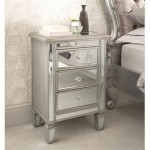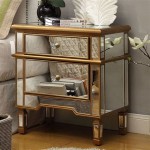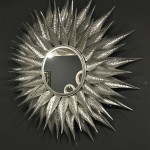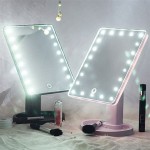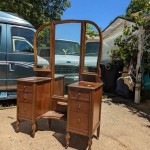Antique Mirrored Furniture: A Timeless Reflection of Elegance
Antique mirrored furniture, with its ability to seamlessly blend functionality and aesthetic appeal, has maintained a prominent position in interior design for centuries. This enduring popularity stems from its capacity to enhance a room's light, create an illusion of spaciousness, and introduce a touch of vintage glamour. Understanding the historical context, stylistic variations, and preservation techniques associated with antique mirrored furniture is essential for both collectors and those seeking to incorporate these pieces into their homes.
The allure of antique mirrored furniture extends beyond its decorative qualities. Each piece often carries a rich history, reflecting the craftsmanship and design trends of its era. From the ornate Rococo dressing tables of the 18th century to the streamlined Art Deco mirrored consoles of the early 20th century, these items offer a tangible connection to the past. Identifying authentic antique mirrored furniture, however, requires a keen eye and a thorough understanding of construction methods, materials, and stylistic hallmarks associated with different periods.
The value of antique mirrored furniture is influenced by several factors, including its age, rarity, condition, provenance, and decorative appeal. Pieces with documented histories, exceptional craftsmanship, or unique designs typically command higher prices. Furthermore, the presence of original components, such as the mirror glass and hardware, can significantly enhance a piece's value. Conversely, extensive damage or poorly executed restoration work can detract from its worth.
Historical Evolution of Mirrored Furniture
The use of mirrors in furniture dates back to ancient civilizations, but it was the development of improved glassmaking techniques in Europe during the 17th century that truly paved the way for the widespread adoption of mirrored surfaces in furniture design. Early examples were often reserved for the wealthy elite, reflecting their status and sophistication. The French court under Louis XIV played a pivotal role in popularizing mirrored furniture, with the Palace of Versailles showcasing elaborate mirrored galleries and furnishings that served as symbols of royal power and opulence.
The 18th century witnessed a proliferation of mirrored dressing tables, cabinets, and decorative panels. These pieces often featured intricate carvings, gilded accents, and delicate mirror work. The Rococo style, with its emphasis on asymmetry, curves, and ornate decoration, heavily influenced the design of mirrored furniture during this period. As the 19th century progressed, mirrored furniture continued to evolve, incorporating elements of Neoclassical, Victorian, and Aesthetic movements. Mass production techniques, while increasing accessibility, also led to a decline in the overall quality and craftsmanship of some pieces.
The Art Deco era of the 1920s and 1930s marked a resurgence in the popularity of mirrored furniture. Designers embraced the sleek lines, geometric shapes, and reflective surfaces that characterized the Art Deco aesthetic. Mirrored consoles, cocktail cabinets, and dressing tables became staples of fashionable interiors. Many of these pieces incorporated innovative materials, such as chrome and Bakelite, alongside traditional materials like wood and glass. This period saw also designers experimenting with the placement and positioning of mirrors, using them to create dramatic visual effects and enhance the perception of space.
Identifying and Assessing Antique Mirrored Furniture
Determining the authenticity and value of antique mirrored furniture requires a systematic approach that considers several key factors. The first step is to carefully examine the piece's construction, looking for evidence of age and craftsmanship. Hand-cut dovetail joints, hand-carved details, and the use of traditional materials such as solid wood and natural veneers are indicative of older pieces. Examining the hardware, including knobs, pulls, and hinges, can also provide clues about the piece's age and origin. Original hardware will often exhibit signs of wear and patina that are difficult to replicate.
The condition of the mirror glass is another important consideration. Antique mirrors often display subtle imperfections, such as minor scratches, bubbles, or cloudiness, that are a result of the manufacturing processes used at the time. The presence of "foxing," a type of discoloration caused by oxidation of the silvering on the back of the glass, is also a common characteristic of older mirrors. While excessive damage can detract from a piece's value, minor imperfections are generally considered acceptable and can even enhance its antique charm. Replacement mirror glass, particularly if it is modern and lacks the characteristics of antique glass, can diminish a piece's authenticity and value.
Provenance, or the documented history of a piece, can significantly enhance its value and desirability. If the furniture has a known history of ownership, particularly if it was once owned by a prominent figure or featured in an important collection, its value will likely be higher. Documentation such as original sales receipts, photographs, or letters can help to establish provenance. It is also important to be aware of potential fakes and forgeries. Thorough research and consultation with experts can help to avoid costly mistakes.
Stylistic analysis involves comparing the piece to known examples of furniture from different periods and regions. Understanding the characteristics of various styles, such as Rococo, Neoclassical, Victorian, and Art Deco, is essential for accurate identification. Examining the piece's design elements, such as its shape, ornamentation, and proportions, can help to determine its stylistic origins. Consulting reference books, museum collections, and online databases can provide valuable information for stylistic analysis. Paying attention to details such as the type of wood used, the design of the legs and feet, and the type of carving or inlay can help determine the origin and date of the piece.
Preservation and Restoration of Antique Mirrored Furniture
Proper preservation and restoration are crucial for maintaining the value and longevity of antique mirrored furniture. Regular cleaning and maintenance can help to prevent damage and deterioration. Dusting the furniture regularly with a soft cloth can remove dirt and debris. Avoid using harsh cleaning products or abrasive materials, as they can damage the finish or scratch the mirror glass. Applying a high-quality furniture polish sparingly can help to protect the wood and enhance its luster.
When restoring antique mirrored furniture, it is essential to prioritize conservation over complete restoration. The goal should be to preserve as much of the original material and finish as possible. Avoid using harsh chemicals or aggressive techniques that can damage the piece. Minor repairs, such as tightening loose joints or repairing small chips in the veneer, can often be performed by a skilled conservator. Replacing missing or damaged hardware with authentic period replacements can also enhance a piece's value and appearance.
The mirror glass itself requires special care. Avoid using harsh cleaning products or abrasive materials on the glass, as they can damage the silvering on the back. Cleaning the glass with a mild solution of water and vinegar or a commercially available glass cleaner is generally safe. When handling antique mirror glass, it is important to wear gloves to prevent fingerprints and scratches. If the mirror glass is severely damaged or deteriorating, it may be necessary to replace it. However, it is important to choose a replacement glass that is as close as possible to the original in terms of thickness, color, and reflectivity. A conservator or restorer specializing in antique mirrors can provide guidance on the best approach to repairing or replacing damaged mirror glass.
Storage conditions play a crucial role in the preservation of antique mirrored furniture. Avoid storing furniture in areas with high humidity or extreme temperature fluctuations, as these conditions can cause damage to the wood and mirror glass. Direct sunlight can also fade the finish and damage the mirror silvering. Storing furniture in a climate-controlled environment is ideal. When moving or transporting antique mirrored furniture, it is important to wrap it securely in protective padding to prevent scratches and damage.

Antique Styled Mirrored Dresser Nightstand Furniture

Antiqued Mirror Chest Currey Company

Antique Mirrored Furniture Eclectic Entrance Foyer Sara Tuttle Interiors

Gold Antique Mirrored Bedside Cleopatra Range Flora Furniture

Decorating With Mirrored Furniture Decor Home

Antique 6 Drawers Dresser Mdf Silver Colour Mirrored Work

30 Unique Mirrored Dressing Tables Guiding Home Painted Cottage Shabby Chic Decor

Antique Styled Mirrored 3 Drawer Chest Furniture

Large Gold Antique Mirrored Chest Cleopatra Range Melody Maison

Make A Statement In Your Bedroom With These 12 Luxury Dressers Furnishmyhome Ca
